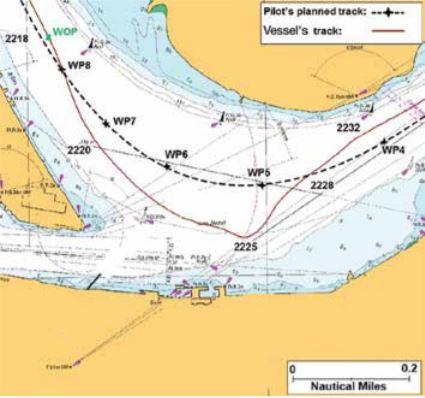201903 Near grounding while exiting port
Edited from official ATSB (Australia) report 330-MO-2017-002
Before a loaded bulk carrier departed, the Master and pilot discussed the pilotage plan, which included the use of four tugs. The pilot’s plan was to remain mid-channel, passing through the pre-established port passage plan waypoints. He was to remain at least 1,000 metres behind another outbound ship to minimise any hydrodynamic interaction between the two vessels.
Once underway, the pilot conned the vessel initially at about 3kt. Speed was slowly increased and was near 5kt as the vessel approached the alteration to port through the final turn of more than 90°. The pilot ordered 10° of port rudder followed by 20°. He wanted a rate of turn of about 13°/minute and he closely monitored the ship’s rate of turn indicator, which was mounted overhead in the bridge front.
The ship’s bow turned to port while the ship continued to track almost straight ahead. Hard port rudder was ordered before the ship slowly began to turn to port. The pilot continued to focus on the rate of turn indicator to see if the ship was turning as quickly as desired. A short time later, when he checked the ship’s position visually, he realised the ship was off the desired route; it was well south of his intended track and closing on an east cardinal buoy. The pilot contacted the tugs to assist the turn. Meanwhile, the Master followed the progress of the ship but did not challenge or intervene because he assessed the actions taken to be appropriate.

The vessel’s speed continued to reduce to about 2.6kt and the bow was swinging to port. Once on a heading of 068° and a speed of about 2kt the pilot ordered slow ahead, followed by half ahead on the main engine. From this point, the ship was successfully manoeuvred back into the channel and out of the port. Some of the report’s findings include:
Insufficient rudder was applied as the vessel started the 90° course alteration to port, and it was applied too late to achieve the necessary rate of turn. As a consequence, the ship went off course and very nearly grounded.
- During the early stages of the turn, the pilot seems to have been focused on the rate of turn indicator, so he was distracted from the primary task of monitoring and controlling the turn. This short period of time was sufficient to compromise control of the turn.
- A shared mental model for the pilotage was not established between the pilot, vessel’s Master and the bridge crew members. In particular, they did not apply techniques such as:
- Ensuring that, prior to the pilot boarding, the pilot and the ship’s crew shared the same plan for the pilotage
- Utilising equipment such as the portable pilotage unit (PPU) to assist explanation of the pilotage stages and parameters
- Ensuring active monitoring, challenge and response/intervention and error management techniques were used by all personnel involved in the pilotage.
Lesson learned
- Similar lessons to MARS 201901.
- As a consequence of this near grounding the port authority decided to amend their procedures to require compulsory carriage of a PPU on all pilotage assignments. For further insights on the PPU, readers might care to refer to the article in this month’s Seaways, The Portable Pilotage Unit: Panacea or Pandora’s Box.
